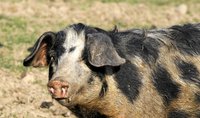The history of Danish historic animals
A new report describes the work on preserving the genetic resources of Danish livestock.

The creatures that walked along the drovers’ road (Hærvejen) across Jutland and the pigs that provided bacon to English households are a part of Danish history. Jutland cattle and Danish Landrace pigs helped create prosperity for Denmark. The Danish-Swedish Farmdog breed was, as working dogs on every farm, an important help in keeping rats and mice at bay.
A new report from the DCA – Danish Centre for Food and Agriculture at Aarhus University – tells the story of Denmark's old livestock breeds. The report describes the qualities of the breeds and how they were created to begin with. It explains the work done to preserve the old breeds so that inbreeding is limited and important genetic resources are not lost.
The colourful booklet is richly illustrated with pictures of the different breeds, and an overview poster is included with the pictures and names of the breeds. Cows, rabbits, sheep, horses, dogs, geese, pigs, goats, pigeons and bees all gain a mention.
Preservation of the old Danish livestock breeds enjoys great interest. Not only are they of particular importance to cultural history; there is also focus on the usage of the races in connection with niche productions. It is also possible that the old livestock breeds carry valuable genes and gene combinations otherwise lost to modern livestock.
Animals of the past
Feral animals were already tamed 10,000 to 11,000 years ago. Feral sheep and goats paved the way, followed by wild boar, aurochs and several other species. After a few thousand years domesticated breeds emerged.
Livestock followed human migration. The introduction of livestock from other countries was, in the first half of the nineteenth century, a common method to improve the local livestock. In this way the so-called rustic breeds emerged, specially adapted to local climates and uses.
The concept of breed was connected to the different physical characteristics, i.e. colour, markings and horns. Special physiological characteristics helped describe the different breeds and their suitability for specific production purposes and production systems.
In 1985 the then Ministry of Agriculture (later the Ministry of Food, Agriculture and Fisheries) established the Committee for the Preservation of Genetic Resources in Danish Livestock, which has functioned up until 2012. The committee was tasked with contributing to the preservation of genetic resources in Danish livestock, and has been responsible for the overall coordination of the work on the genetic resources of livestock.
The purpose in preserving the genetic resources of livestock is to ensure that genetic variation is preserved, so that livestock can also be adapted to future production requirements. An example might be climate change, which is expected to affect production conditions. The preservation of genetic resources is thus intended for both the old breeds deserving of preservation as well as the modern livestock breeds.
The report (in Danish) ”Danske husdyrgenetiske ressourcer”, DCA report no. 14, December 2012.
For further information please contact:
Associate Professor Vivi Hunnicke Nielsen
Department of Molecular Biology and Genetics
Aarhus University, Denmark
email: vivih.nielsen@agrsci.dk, mobile telephone: +45 2219 1351
